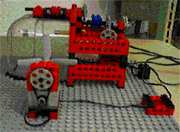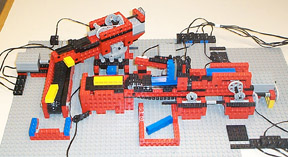|
Hands-on Applied Physics along with Computer-Controlled Robotics
An educator shares her successes
implementing a high-tech learning program into elementary and middle
school curriculums.
By Beverly Leete
|
|
 o begin implementing innovative, high-tech learning programs, teachers are going to have to be prepared with technical knowledge through extensive training. Lego Dacta has a program I am currently using in my classroom. Teachers across the country are very enthusiastic about this program, and I deem it a top priority to get teachers excited about a program that promotes the potential for innovation and entrepreneurship so necessary for the success of our students - their future and ours. o begin implementing innovative, high-tech learning programs, teachers are going to have to be prepared with technical knowledge through extensive training. Lego Dacta has a program I am currently using in my classroom. Teachers across the country are very enthusiastic about this program, and I deem it a top priority to get teachers excited about a program that promotes the potential for innovation and entrepreneurship so necessary for the success of our students - their future and ours.
Applied Technology is our most essential and main manufacturing concern today. Yet the most essential technology skills are not being taught in many of today's educational curriculums. Simple applied physics' programs in the early grades should be designed to better prepare the graduates of tomorrow for the global workplace they will be entering and in which they will be competing.
|
|
Check out all of the Standards
applicable to this story!
ISTE technology standards
II. Social, ethical, legal, and human issues.
III. Technology productivity tools
National English Language Arts Standards
XII. Applying language skills
Math Standards
II. Communication
Click here for
a detailed
description.
|
|
|
 he
impetus behind this dedication to school is a modification of the elementary/middle
school curriculum towards more technical knowledge and expertise, coupled
with an atmosphere of teamwork, cooperation, and freedom that allows
students to explore and learn practical, future work skills that can
be of great benefit, whether they plan on going to college or entering
the work world right out of high school. he
impetus behind this dedication to school is a modification of the elementary/middle
school curriculum towards more technical knowledge and expertise, coupled
with an atmosphere of teamwork, cooperation, and freedom that allows
students to explore and learn practical, future work skills that can
be of great benefit, whether they plan on going to college or entering
the work world right out of high school.
Students learn technical reading, writing, collaboration, and problem solving with the use of Legos. The hands-on instruction using Legos includes principles of work, inclined planes, levers, pulleys, wheels and axles, pneumatics, gear-driven operations, and robotics. The concepts of simple machines are easily understood and then used to make more complicated designs.
|
|
 hrough a structured, outlined course of study, students learn to build
actual working models of various pieces of equipment. With the use of
computers, creations become automated. In essence, the classroom becomes
a research and development center, as student teams are involved in
the design, construction, operation, and modification of actual robotic
simulations. Machines are controlled with the use of buttons and/or
sensors such as touch sensors and temperature probes. Motor control
and computer programming are also learned. Time is also provided for
students to engage in the creation of new inventions of their own design
which students will take from the drawing board to the final product.
In these open-ended activities, students discover important technology
concepts. hrough a structured, outlined course of study, students learn to build
actual working models of various pieces of equipment. With the use of
computers, creations become automated. In essence, the classroom becomes
a research and development center, as student teams are involved in
the design, construction, operation, and modification of actual robotic
simulations. Machines are controlled with the use of buttons and/or
sensors such as touch sensors and temperature probes. Motor control
and computer programming are also learned. Time is also provided for
students to engage in the creation of new inventions of their own design
which students will take from the drawing board to the final product.
In these open-ended activities, students discover important technology
concepts.
Students have an introduction to computer-controlled technology with a simple fan-control project. With step-by-step building instructions, students construct a fan from Legos. Lego-Dacta's Control Lab building materials and software are used for this project.
|
|
|
|
"In
essence, the classroom becomes a research and development center, as
students teams are involved in the design, construction, operation,
and modification of actual robotic simulations."
|
|
 tilizing an interface box, students use a temperature probe to test
different water temperatures. Inputs can be temperature probes, touch,
light, angle or rotation sensors. Outputs can be motors or lights. tilizing an interface box, students use a temperature probe to test
different water temperatures. Inputs can be temperature probes, touch,
light, angle or rotation sensors. Outputs can be motors or lights.

Students write a simple program determining at what temperature the fan motor will be turned on or off.

|
|
 tudents then develop a page
where they will control the entire operation. The page contains two
text fields - one for the title, and one for documentation. There is
a slider bar, which controls the output of the motor. The button turns
the program off or on. A monitor shows the current temperature of the
probe. A graph keeps a continual record of the time and temperature.
Students may zoom in on the graph to find the temperature and time at
any given point. tudents then develop a page
where they will control the entire operation. The page contains two
text fields - one for the title, and one for documentation. There is
a slider bar, which controls the output of the motor. The button turns
the program off or on. A monitor shows the current temperature of the
probe. A graph keeps a continual record of the time and temperature.
Students may zoom in on the graph to find the temperature and time at
any given point.

Fan Control Page |
|
| |
|
 tudents
then construct a house, which utilizes this machine as a thermostat-controlled
ceiling fan. The house also contains a touch sensor, which controls
the motor attached to the garage door. A light sensor activates a light
above the door. Another light sensor registers the light intensity of
a colored "key" which is inserted into the front door. If the right
key is used, an automatic doorlock is rotated 90 degrees to an open
position. tudents
then construct a house, which utilizes this machine as a thermostat-controlled
ceiling fan. The house also contains a touch sensor, which controls
the motor attached to the garage door. A light sensor activates a light
above the door. Another light sensor registers the light intensity of
a colored "key" which is inserted into the front door. If the right
key is used, an automatic doorlock is rotated 90 degrees to an open
position.

Greenhouse |
|
 or the students' final project, they may choose to build a greenhouse,
robotic arm, dynamometer, joystick-operated wheelchair, vending machine,
scanner, conveyor, or an invention of their own (with prior approval
of their technical drawing and writing). or the students' final project, they may choose to build a greenhouse,
robotic arm, dynamometer, joystick-operated wheelchair, vending machine,
scanner, conveyor, or an invention of their own (with prior approval
of their technical drawing and writing).

Conveyer Project |
|
| |
|
|
 ive
Rose Hill Middle School students participated in the Kansas State Education
Technology Fair held at the State Capitol in Topeka on Thursday, February
12, 1998. This fair featured 20 exemplary school programs. They then
competed and took first place in regional competition with their simulation
of a Wood-Sorting machine. ive
Rose Hill Middle School students participated in the Kansas State Education
Technology Fair held at the State Capitol in Topeka on Thursday, February
12, 1998. This fair featured 20 exemplary school programs. They then
competed and took first place in regional competition with their simulation
of a Wood-Sorting machine.
This machine consisted of three conveyor
systems and a robotic arm. Different kinds of "wood" (yellow
and blue blocks) were placed on the first conveyor. After dropping at
an assigned rate to another conveyor belt, each block of wood ran under
a light sensor. Based upon the intensity of light from this block, either
a motor would be activated to push the block into a bin, or the conveyor
would carry the block to a robotic arm. Here the robotic arm would grip
the block of wood, and using an angle sensor, would turn to place the
block on yet another conveyor. A touch sensor, sensing that a block
was on the belt, would then activate a motor which would cause this
conveyor to carry the block of wood to a point at which it was dropped
into a different bin.
|
|
 hese
activities meet or exceed national standards in the areas of math, science,
and technology. For information about correlations to standards in your
state, contact Pitsco-Lego Dacta at www.pitsco-legodacta.com/html/standards.html. hese
activities meet or exceed national standards in the areas of math, science,
and technology. For information about correlations to standards in your
state, contact Pitsco-Lego Dacta at www.pitsco-legodacta.com/html/standards.html.
For Mapping of the Technology Curriculum
Module Content
- Students utilize and program a robot to understand and explore
the many uses of a robot in industry
- Students learn aspects of manipulation of the robot
Essential Questions
- How are robots used in different industry situations?
- What are the different parts of a robotic arm? How do they move?
- How do you manipulate a robot in a remote location away from direct
view?
|
|
| "These
activities meet or exceed national standards in the areas of math, science,
and technology." |
|
|
 kills
kills
- Use a computer screen to control a robotic machine to do a specific
task
- Manipulate the robot in a remote location away from direct view
via a
televised image of the work task
- Recognize the importance of robotics in industry - communication,
transportation, aeronautics
- Construct and program a thermostat-controlled fan unit
- Construct and program an "intelligent house" complete
with lights, burglar
alarm, door lock with color-key entry, thermostat-controlled ceiling
fan,
garage door, etc.
- Contruct and program a robotic arm
- Assemble mechanical linkages
- Technical reading
- Inventory and parts control
|
|
 ssessment ssessment
- Assembled robot that performs a particular function
Equipment
- Lego Dacta Intelligent House
- Lego Dacta Control Lab
- Macintosh or PC
- Manual written by Beverly Leete
During the past eleven years, I have been administering hands-on workshops on the subject of applied physics (simple machines/robotics) and computer-controlled robotics. I have been active in curriculum development in the applied physics' area since 1990. As a National Applied Physics' Consultant, I have presented at National Conventions, State Board of Educations, local Board of Educations, school districts, service centers, and various private and state conventions. Statewide, I have been presenting my own interdisciplinary units in other content areas since 1985. I have 21 years experience in the classroom, with a computer science degree, elementary education degree from PSU, and a masters from Wichita State. I also attended Apostolic Faith Bible College. My husband and I have two sons and currently reside in Rose Hill.
|
|
| |
|
|
For information about products
used, contact Pitsco Lego Dacta at 1-800-362-4308.
For information about
written curriculum for the above-mentioned products, contact Beverly
Leete at bevleete@aol.com or 316-776-0627.
|
|






